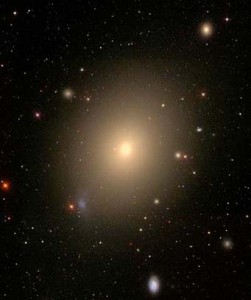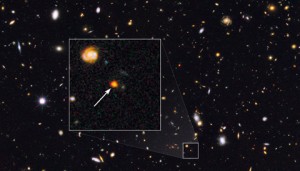Astronomers are tracking down the seeds that likely grew to become today’s most massive elliptical galaxies.

Astronomers like galactic runts. It’s not that they’re cute — although the Large Magellanic Cloud is vaguely reminiscent of a fuzzy caterpillar. It’s that runts were likely the building blocks of the big galaxies we see today.
The largest, most massive galaxies in the local universe are ellipticals, big golden clouds of stars that have burned through their star-forming gas reservoirs and now sit “quiescent,” enjoying old age. But about a decade ago, astronomers looking into the early universe discovered that quiescent galaxies 10 or 11 billion years ago were actually the smallest galaxies around, roughly one-tenth the size of today’s ellipticals and one-third (or less) that of the other star-forming galaxies at that epoch.
Even so, the compact galaxies were massive: in stars they can outweigh the Milky Way, even though they’re on the order of one-tenth the size.
These compact quiescents likely grew into the red-and-dead behemoths of today. Three lines of evidence point to that interpretation, explains Guillermo Barro (University of California, Santa Cruz). One, there are very few compact quiescent galaxies today, so they must have disappeared somewhere. Two, the density of stars in these ancient, compact galaxies is similar to that in the cores of local, big ellipticals. And three, if the compact galaxies grew by merging with less massive companions (probable), the mergers would have preferentially built up the galaxies’ outer edges, leaving the core more or less unchanged (explaining #2).
. . . But where did the cores come from?
Astronomers potentially found an answer to that question in the last year or so when they discovered compact, star-forming galaxies that existed around 11 billion years ago (a.k.a. at a redshift of about 2). These star-forming galaxies had sizes and masses similar to the compact, quiescent galaxies.

NASA / ESA / E. Nelson (Yale University)
Now, two teams have confirmed that the velocity of gas moving around inside several of these small star-forming galaxies matches the velocities of stars in the small quiescent ones. It’s this gas that forms stars, so if the dynamics of the gas match the dynamics of the stars, that’s a pretty good indicator that we’re looking at the same type of beast at different ages.
Both Barro and his colleagues and an independent team comprising Erica Nelson (Yale) and her colleagues came to this conclusion using multiwavelength data for compact galaxies found in the GOODS and COSMOS surveys. These objects all have redshifts between 1.97 and 2.49, meaning they existed right at the time the transition seems to have happened. They also have stellar masses ranging from 40 billion to 200 billion Suns. (The Milky Way has a total stellar mass at the lower end of this range.)
Assuming the gas motions calculated are for gas that’s settled into these compact galaxies and isn’t infalling or outflowing (and the teams are pretty sure that’s true), and assuming no more gas will dump down onto these cores, star formation will burn through the available gas in a few hundred million years. Feedback from gas-guzzling, jet-spewing supermassive black holes might exacerbate the quick death by removing gas, too. Barro’s team found X-ray evidence for an active galactic nucleus (AGN) in 7 of the 13 galaxies it studied, while Nelson’s team saw no sign of an AGN in the galaxy it analyzed.
This timeline puts the compact, star-forming galaxies right on track to become the small, quiescent galaxies observed. They’ll probably all be “dead” in 1 to 2 billion years, or at a redshift of 1.5 or so. Afterwards, they will (we think) build up their outer edges to become today’s massive ellipticals.
This all works very nicely. But it does raise a big-picture question. Last year Nelson and other members of her team observed the growth of less massive, disk galaxies (similar to the Milky Way) between 7.5 and 11 billion years ago. The observations showed that such galaxies built up both their core bulges and their disks at the same time. But the new results confirm that more massive, elliptical galaxies likely grew from the inside out. Why the difference? Perhaps because ellipticals tend to grow in denser parts of the universe (true); perhaps because the universe itself was denser billions of years ago (also true). Or perhaps there’s something else going on.
References:
G. Barro et al. “Keck-I MOSFIRE Spectroscopy of Compact Star-forming Galaxies at z>2: High Velocity Dispersions in Progenitors of Compact Quiescent Galaxies.” arXiv.org. Posted May 27, 2014.
E. Nelson et al. “A Massive Galaxy in its Core Formation Phase Three Billion Years after the Big Bang.” Nature. August 27, 2014.
Find galaxies for yourself using our latest e-book, Summer Deep Sky.
 1
1









Comments
Peter Wilson
August 29, 2014 at 7:52 pm
"But about a decade ago, astronomers looking into the early universe discovered that quiescent galaxies 10 or 11 billion years ago were actually the smallest galaxies around...one, dubbed GOODS-N-774 (inset), sticks out as a compact yet massive galaxy that’s producing stars at a rate roughly 90 times that of the Milky Way."
That doesn't sound very quiescent...
You must be logged in to post a comment.
You must be logged in to post a comment.